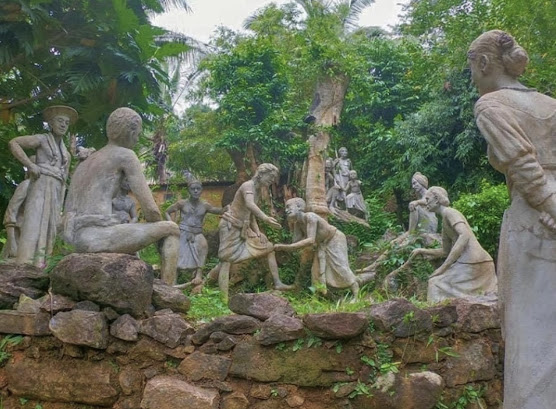“Saradiel Village” – authentic legend of ‘Robin Hood of Ceylon’ – By Arundathie Abeysinghe

 Situated approximately one kilometer from Uthuwankanda junction in Mawanella, two kilometers from the Colombo – Kandy Road, near *Uthuwankanda Rock, Saradiel Village is a theme park depicting the life of Saradiel (Dekirikewage Saradiel also known as “Uthuwankande Soora Saradiel” by locals), a bandit who later became a gang leader.
Situated approximately one kilometer from Uthuwankanda junction in Mawanella, two kilometers from the Colombo – Kandy Road, near *Uthuwankanda Rock, Saradiel Village is a theme park depicting the life of Saradiel (Dekirikewage Saradiel also known as “Uthuwankande Soora Saradiel” by locals), a bandit who later became a gang leader.
Visiting Saradiel Village gives the visitor an understanding of Saradiel’s authentic story as well as the life of 18th century Ceylon. Declared open in 2012, approximately six acres has been utilized to create this 18th century traditional village. Although, constructed with cement, skillfully-built statues give visitors an impression as if they are alive. The artificially-built theme park similar to a hamlet offers glimpses and noteworthy moments in the life of Saradiel. Local as well as foreign tourists, mostly school children visit the theme park daily to see the legends brought to life.
During opening times, the theme park is brimming with activity. Upon entry to Saradiel Village, a visitor is greeted by the *Arachchi (headman). Until his arrival, tourists who visit the theme park can relax in the *Ambalama (wayside-inn).
The Bazaar in Saradiel’s Village is a busy location. There are sculptures depicting a typical day at Hendrick Appuhamy’s Kopi Kade (meaning Coffee Shop). There is Pichohamy (Saradiel’s mother) serving coffee while a Malay Police Officer enjoys a helapa (a traditional Sri Lankan sweet treat wrapped in a kenda leaf – Macaranga peltate). In front of the shop, there is a gypsy snake charmer entertaining the passers-by with his acrobatic monkey. Adjacent to the coffee shop, there is a tavern. In the past, village men visited a tavern for a pint of toddy (an alcoholic beverage made from the sap of diverse species of palm tree).
There is a traditional Sri Lankan Clay House in the theme park depicting the way of life that existed in the 18th century. The Clay House consisted of different sections known as Diyapila, Watapila and Kottapila. In the past, males of a family would sleep in the Kottapila to guard the house from outsiders. There is a big clay cauldron on the Diyapila that was utilized to quench the thirst of visitors. On the clay wall, there is a built-in shelf to place the trunk pettiya (box) in which valuable belongings were kept. Outside the house, there is a Vee Bissa (Paddy Repository), a feature that exists in village houses, to date. There are several other traditional village houses such as the astrologer’s house, carpenter’s atelier, workshops of the goldsmith and potter in the village. There is also a Dandu Kadaya (a torture device that was utilized as a method of punishment that was inflicted on condemned men in the past).
During the second half of the tour, visitors can listen to the tale of Saradiel’s childhood and rebellion days. Thereafter, the Arachchi would stop at the ferry, near “Tikiri Menike’s kitchen” (the kitchen of a village female displaying a typical village kitchen and its daily routine) and laundry man’s house to describe the lifestyle of a typical 18th century village that includes trading activities, in the past.
At the end of the tour, visitors can travel towards the spectacular gushing cascade “Bo Waterfall” that has a mesmerizing rock pool. Some tourists visit Uthuwankanda Rock after visiting the theme park.
The sculptures perfectly reflect the ethnic harmony and diversity which existed during the *Kandyan era.

Image courtesy – travelwithuma.com
- Ambalama – A simple ancient Sri Lankan structure constructed to provide shelter for pilgrims, traders as well as travelers to rest. They played a significant role in traditional Sinhalese culture. During the Kandyan period, they served as resting places, refuges and free overnight accommodations along several pilgrimage routes. Centuries ago, merchants, pilgrims and travelers stayed in an ambalama to take a respite from their long journeys. Ambalama was built and designed as an architecturally simple structure with the purpose of providing shelter for the travelers. An ambalama also served diverse purposes in historical times and are still in use as a place for a tea break or as a hut of farmers. In the past, Gam Sabhawa (village tribunal) also assembled in an ambalama. Village headmen, aristocrats on palanquins, traders on bullock carts, travelers as well as people from all walks of life used to frequent an ambalama. It also served as a meeting place for the village folk to exchange gossip, pleasantries and discuss politics.
- Arachchi – An influential post in the native headmen system in Ceylon (present Sri Lanka) during the British Colonial Era appointed by the *Government Agent. The holder of the position had much control over the people of the area and wielded quasi-judicial powers (a non-judicial body which can interpret law) and he was responsible to keep peace, carry out revenue collection as well as assist in judicial functions. Appointments for the position were non-transferable and usually hereditary to locals from wealthy influential families loyal to the British Monarchy.
- Government Agent (GA) – At present, a Government Agent is known as District Secretary. A GA is a Sri Lankan civil servant of the Sri Lanka Administrative Service (SLAS) appointed by the central government to govern a certain district in Sri Lanka.
- Kandyan era – Kandyan period lasted from 1597-1815, the last independent monarchy of Sri Lanka located in the central region. Kandyan Kingdom was independent from Portuguese and Dutch rule. Later, the Kingdom was colonized by British Colonials, in 1815.
Panavitiya Ambalama – paradigm of Sri Lankan architecture By Arundathie Abeysinghe
Uthuwankanda – hideout of “Robin Hood of Sri Lanka” By Arundathie Abeysinghe
https://www.elanka.com.au/uthuwankanda-hideout-of-robin-hood-of-sri-lanka-by-arundathie-abeysinghe/







